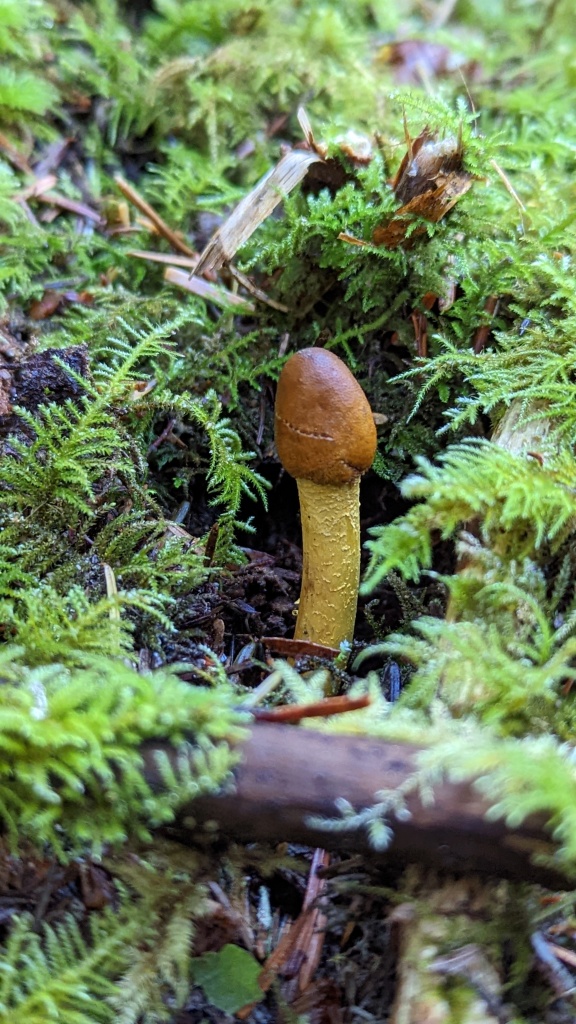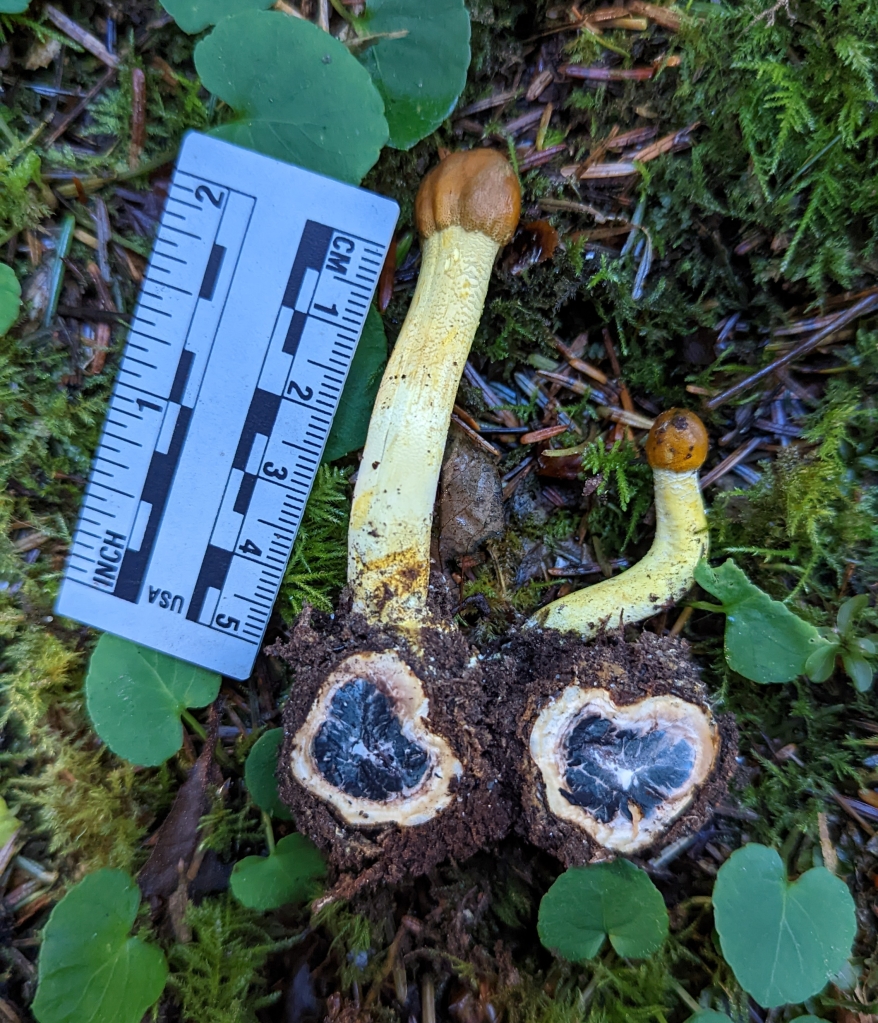Ever heard of one? One what? You might be asking . . . it’s a fungus of course! Two actually . . . kinda! The common name is not just four random words smashed together, it actually represents the two fungal organisms that come in one funky package.
Overall, the fungi in question is a truffle that’s been parasitized by a Cordyceps fungus. One part of this fungal beast is Elaphomyces granulatus, the truffle part, the dark ball-like structure, the other part is a Cordyceps fungi, a parasitic fungi known as Tolypocladium capitatum, the long mushroom-like structure. Its common name for this funky structure? The Drumstick Truffleclub!
Cordyceps
The Cordyceps fungus here is Tolypocladium capitatum; visually it’s the long mushroom-like shoot. Cordyceps fungus are most well known for their ability to take over insects, and send their shoots out in spectacular spikes.
The yellow stipe (stalk) can be 2cm to 8cm long, and the brown pimply cap (head) is only 0.5 to 2cm long. The head contains pores that allow the spores to exit, and hopefully infect another truffle.
The second one I ever saw, actually had two C. capitata emerging from a singular truffle, which is apparently common. As it was excavated, the tree roots provided some challenging conditions and ended up decapitating the Cordyceps off the truffle. Hopefully, in the photo, you can’t tell about our little mishap. But you can watch part of the extraction in the video above this section of text.



Elaphomyces
Elaphomyces is a genus of fungi known as false or deer truffles, the black ball-like structure.
As you may know, truffles live underground, so without the cordyceps fungi this fungus would be hard to find for us humans. The outer layer of the truffle is called the perithecia. This produces spores for the truffle. Inside are embedded ascus, which is a saclike structure that stores spores, that were sexually produced.
Habitat
My first sights on these fungi were with my friend Mandy in Sitka Spruce habitat with the other main foliage being salal, evergreen huckleberry, cascara, and the occasional douglas fir. It was truly tucked into the moss. Mandy had warned me that they only extend a small portion above the substrate, so they often go overlooked.
This past weekend (American Thanksgiving 2022) Trevor and I found quite the little pocket of drumstick truffleclubs. They were growing on an old logging road in the depths of a secondary coastal redwood forest. Once Trevor spotted one, many more were evident nearby.




Range
The drumstick can be found in coniferous and mixed forests across the globe. At least in California and the West Coast it shows up in fall and winter, and are generally rare.
Tolypocladium capitatum can be found in North America and in Europe.
History & Taxonomy
This funky fungus has had many names throughout its years.
Entomologically, Cordyceps can be broken down into cord, meaning club, and ceps meaning head. Club-head. Secondly, capitata means ‘having a head.’
It was first named in 1790 by Theodor Holmskjold, given the name Sphaeria capitata. Then in 1833 it became Cordycepts capitata. Historically there are three more names but in the present day it’s referred to in some websites as Elaphocrodycepts capitata, but Tolypocladuum is the most updated. Don’t come after me fungi fanatics, I’m trying my best.
As a genera, Tolypocladium includes 41 species, of which some are in biopharmaceuticals and in biocontrol (Yu et al., 2021). Within this genera are fungi that are “saprotrophic soil inhabitants, plant endophytes and pathogens of insects, nematodes, rotifers, and parasites of truffle-like fungi (Yu et al., 2021).


Edible?
One comment on Mushroom Observer suggests leaving this truffle in the dirt, instead of your plate. In general, Tolypocladium capitatum should be avoided, according to this First Nature article. Mushrooms of the Redwood Coast suggests it tastes indistinct. Soooo up to you.

Ponderings
It’s quite the thing to ponder how Tolypocladium capitatum came to replicate the shape of a mushroom when a lot of other Cordyceps fungi have structures that are quite stick-like. How exactly the spores of the T. capitatum find a truffle to parasitize in the first place? Does the stage of the truffle matter? In other words, is it parasitize-able at any size or stage? Can the T. capitatum spore parasitize the truffle mycelium? Or when it’s in its fruiting stage, the truffle we see in photos? Soo many mysteries the fungal world poses.
If any part of this post makes you curious to go found your own Drumstick Truffleclub, check this iNaturalist map to see if others have found this fun fungus near you, and go out and try and find it!

Happy Mushrooming!
Resources:
- Mushroom Observer, Cordyceps capitata
- First Nature, Cordyceps capitata
- Mushrooming, Northern Hemisphere Cordyceps Yu, Feng-Ming, et al. “Comprehensive Review of Tolypocladium and Description of a Novel Lineage from Southwest China.” Pathogens 10.11 (2021): 1389.
- MykoWeb: Elaphomyces granulatus, Elaphomyces muricatus
- Mushrooms of the Redwood Coast : a comprehensive guide to the fungi of coastal northern California by Noah Siegel and Christian Schwarz
I am not a member of the Drumstick Truffleclub but I want to be :). I did not notice your little mishap while exploring these interesting discoveries. I always enjoy your creative side of writing while exploring nature!xxx
LikeLike
Hehe. Thanks so much for reading the post 🫶
LikeLike
I found these in my backyard in Charleston, SC!? Very interesting that they’re only really known to be on the West Coast. Thank you for all of the info, this is a great post.
LikeLike
That’s awesome! Woot woot! Thanks for reading my post, and the lovely comment!
LikeLike